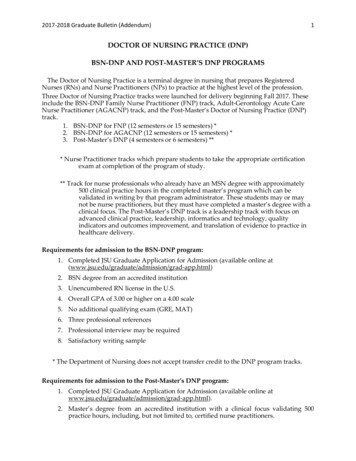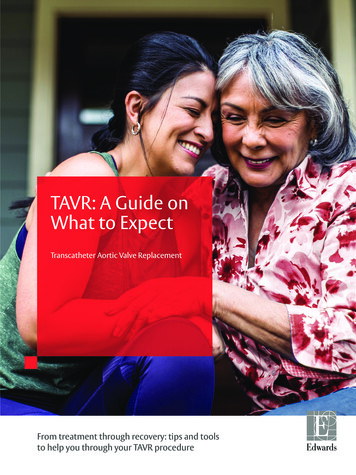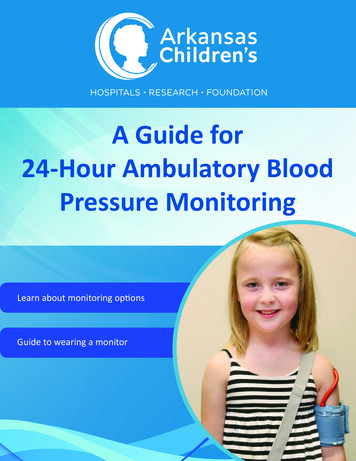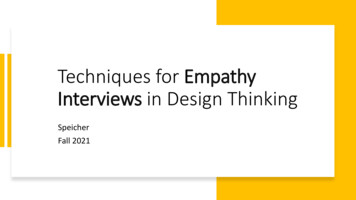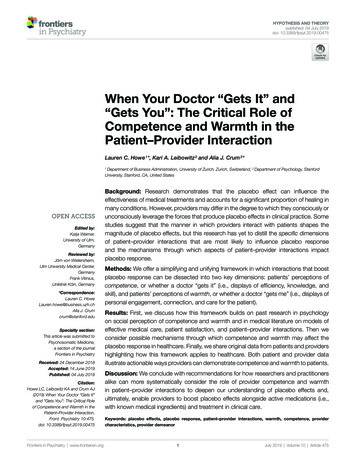
Transcription
HYPOTHESIS AND THEORYpublished: 04 July 2019doi: 10.3389/fpsyt.2019.00475When Your Doctor “Gets It” and“Gets You”: The Critical Role ofCompetence and Warmth in thePatient–Provider InteractionLauren C. Howe 1*, Kari A. Leibowitz 2 and Alia J. Crum 2*Department of Business Administration, University of Zurich, Zurich, Switzerland, 2 Department of Psychology, StanfordUniversity, Stanford, CA, United States1Edited by:Katja Weimer,University of Ulm,GermanyReviewed by:Jörn von Wietersheim,Ulm University Medical Center,GermanyFrank Vitinius,Uniklinik Köln, Germany*Correspondence:Lauren C. HoweLauren.howe@business.uzh.chAlia J. Crumcrum@stanford.eduSpecialty section:This article was submitted toPsychosomatic Medicine,a section of the journalFrontiers in PsychiatryReceived: 24 December 2018Accepted: 14 June 2019Published: 04 July 2019Citation:Howe LC, Leibowitz KA and Crum AJ(2019) When Your Doctor “Gets It”and “Gets You”: The Critical Roleof Competence and Warmth in thePatient–Provider Interaction.Front. Psychiatry 10:475.doi: 10.3389/fpsyt.2019.00475Frontiers in Psychiatry www.frontiersin.orgBackground: Research demonstrates that the placebo effect can influence theeffectiveness of medical treatments and accounts for a significant proportion of healing inmany conditions. However, providers may differ in the degree to which they consciously orunconsciously leverage the forces that produce placebo effects in clinical practice. Somestudies suggest that the manner in which providers interact with patients shapes themagnitude of placebo effects, but this research has yet to distill the specific dimensionsof patient–provider interactions that are most likely to influence placebo responseand the mechanisms through which aspects of patient–provider interactions impactplacebo response.Methods: We offer a simplifying and unifying framework in which interactions that boostplacebo response can be dissected into two key dimensions: patients’ perceptions ofcompetence, or whether a doctor “gets it” (i.e., displays of efficiency, knowledge, andskill), and patients’ perceptions of warmth, or whether a doctor “gets me” (i.e., displays ofpersonal engagement, connection, and care for the patient).Results: First, we discuss how this framework builds on past research in psychologyon social perception of competence and warmth and in medical literature on models ofeffective medical care, patient satisfaction, and patient–provider interactions. Then weconsider possible mechanisms through which competence and warmth may affect theplacebo response in healthcare. Finally, we share original data from patients and providershighlighting how this framework applies to healthcare. Both patient and provider dataillustrate actionable ways providers can demonstrate competence and warmth to patients.Discussion: We conclude with recommendations for how researchers and practitionersalike can more systematically consider the role of provider competence and warmthin patient–provider interactions to deepen our understanding of placebo effects and,ultimately, enable providers to boost placebo effects alongside active medications (i.e.,with known medical ingredients) and treatment in clinical care.Keywords: placebo effects, placebo response, patient–provider interactions, warmth, competence, providercharacteristics, provider demeanor1July 2019 Volume 10 Article 475
Howe et al.Provider Warmth and CompetenceINTRODUCTIONin the medical literature on patient–provider interactions byreviewing theoretical and empirical work on effective patient–provider interactions.The doctor has been called “a powerful therapeutic agent”(p. 1,067) (1) who can evoke healing in her or his patientseven by simply interacting with them. One way providers canhelp their patients heal, and the focus of this paper, is througheliciting placebo effects, or “healing that is produced, activated,or enhanced by the context of the clinical encounter, as distinctfrom the specific efficacy of treatment interventions” (2). Diversefactors can produce placebo effects, including medical rituals(e.g., taking a pill) and provider behaviors (e.g., communication).For example, providers explicitly stating to patients that atreatment will improve their condition makes it more likely thatthe treatment will do so (3, 4). Placebo effects bolster the efficacyof both active medications (5–7) and treatments with no activemedical properties, ranging from sugar pills (8) to inert creamsdescribed as pain relievers (9) to sham acupuncture involvingfake needles that never pierce the skin (10).But not all placebo effects are created equal. A series of studiessuggests that how providers interact with their patients shapesthe magnitude of placebo effects (10–13). But while these studiesacknowledge that patient–provider interactions are critical toplacebo response, they do not provide a theoretical frameworkfor the specific dimensions of the patient–provider interactionthat enhance placebo effects and thus shape a patient’s physicalhealth outcomes.In the current article, we address four key questions, whichcorrespond to the four main sections of the article:Competence and Warmth: Two CoreDimensions of Social PerceptionPsychologists have long been interested in understanding thedimensions on which people judge others when forming firstimpressions. In order to successfully navigate one’s social world,a person must constantly and rapidly make accurate assessmentsof other people. Should a stranger be approached or avoided? Is aperson a suitable friend or romantic partner? Is an expert worthy oftrust? To answer such questions, people need to quickly determinewhether another person is likely and able to harm or help them.Although many dimensions for the factors that underlie suchsocial judgments have been proposed, over 50 years of researchsuggests that they can all be distilled into two key dimensions:warmth and competence (14–20).One study attempting to identify the underlying dimensionsof personality asked participants to describe different people theyknew by selecting personality traits from a list of over 60 differenttraits (21). These researchers then evaluated the degree to whichthese traits co-occurred in people’s descriptions of a particularperson. They found the traits that co-occurred frequently couldbe grouped into those that described intellectual qualities thatwere either good or bad (i.e., competence—e.g., qualities likedetermined and industrious vs. irresponsible and unintelligent)and social qualities that were good or bad (i.e., warmth—e.g.,qualities like sincere and good-natured vs. irritable and humorless).These two dimensions were independent and accounted for mostof the variance in people’s judgments of others.In other research, participants generated descriptions of eventsthat helped them form strong impressions of other people orthemselves (22). Of the over 1,000 descriptions generated by theseparticipants, approximately three-fourths depicted considerationsof warmth or competence, as rated by independent judges. In yetanother study, a pool of 200 diverse traits were rated on a variety ofdimensions, including the degree to which they captured warmthand captured competence (23). These ratings of a trait’s warmthand competence predicted all but 3% of the variance in ratings oftrait favorability, suggesting that these two ingredients are key todescribing positive and negative qualities in person perception.Together these studies, and dozens of others using a varietyof methodologies, suggest that warmth and competence are twokey dimensions holding the greatest explanatory power when itcomes to positive and negative evaluations of others.1 Qualitieslike friendliness, honesty, trustworthiness, good-naturedness,empathy, and kindness (vs. coldness, deceit, and unreliability) areall essentially different ways to describe a person’s general warmth.1. What are the key dimensions of patient–provider interactions?2. In what ways do these dimensions moderate placebo response?3. What are the mechanisms through which these dimensionsmoderate placebo response?4. How can providers leverage these dimensions deliberately inclinical care?In considering these questions, we delineate a novel frameworkproposing that interactions that boost placebo response canbe dissected into two key dimensions: patients’ perceptions ofcompetence, or whether a doctor “gets it” (i.e., displays of efficiency,knowledge, and skill) and patients’ perceptions of warmth, orwhether a doctor “gets me” (i.e., displays of personal engagement,connection, and care for the patient). We suggest that competenceand warmth work together to influence placebo response andtherefore shape effective healthcare.WHAT ARE THE KEY DIMENSIONSOF PATIENT–PROVIDER INTERACTIONS?Is there a parsimonious way to represent the many diverse qualitiesthat may be present in patient–provider interactions? We tacklethis question in three steps. First, we discuss the psychologicalliterature on social perception, which identifies key dimensionsthat underlie our impressions of others. Second, we introducea model of patient–provider interactions that explains howkey dimensions from social perception apply in the healthcarecontext. Third, we illustrate how these key dimensions are evidentFrontiers in Psychiatry www.frontiersin.orgFor example, the dimensions of warmth and competence also model people’sjudgments of the characteristics of social groups. Ratings of warmth and competencedistinguished a variety of different social groups on the basis of out-group members’stereotypes about these groups (24). Stereotypes of groups could be categorized intofour unique clusters: those rated high on warmth and competence, low on warmthand competence, high on warmth but low on competence, and low on competencebut high on warmth.12July 2019 Volume 10 Article 475
Howe et al.Provider Warmth and CompetenceJudgments of Competence and Warmthin Healthcare: The Provider “Gets It”and “Gets Me” FrameworkQualities like intelligence, power, assertiveness, ambition, efficacy,and skill (vs. inefficiency, indecisiveness, passivity, and laziness)are all essentially different ways to describe a person’s generalcompetence (15, 20). Though these dimensions have sometimesbeen called by other names [e.g., agency and communion (25–27); for a review see Ref. (17)] regardless of the nomenclature,there is remarkable consistency among researchers in the qualitiesthat are commonly reflected by these two dimensions.There is a strong evolutionary argument for the primacy ofwarmth and competence: the need to rapidly determine whethera person intends to, and is capable of, harming or helping anindividual. Essentially, warmth encapsulates answers to thequestion of “Are this person’s intentions toward me positive ornegative?” and competence encapsulates answers to the questionof “Does this person have the ability to enact those positive ornegative intentions?” (14). To promote survival, a person mustbe able to find an answer to these key questions whenever theyencounter someone new.And indeed, people make these judgments rapidly and nonconsciously, any time they evaluate someone new. People judgeothers as warm or competent based on even brief exposure toanother person’s behavior (28–30). For example, both adultsand children form evaluations of warmth and competence afterbrief, 100-millisecond exposure to a person’s face (31, 32). Thesetwo dimensions are readily perceived from a variety of limitednon-verbal information, such as tone of voice, body posture, andfacial expressions (33–35). Further, ratings of warmth predictliking and ratings of competence predict respect for others (25,36). Warmth and competence thus seem likely to influence boththe quality and outcomes of a variety of important interpersonalinteractions, including patient–provider interactions.In summary, decades of research in social, evolutionary, andcognitive psychology have shown that a multitude of qualitiescan essentially be distilled into the two core dimensions ofcompetence and warmth, and that these dimensions arefundamental to how people form impressions of others. Next, weapply this competence and warmth framework to healthcare.Patients’ assessments of a provider likely also follow these two keydimensions of social perception, but with a slightly different flavor.We propose a healthcare-specific framework in which patientsassess competence by judging whether the provider “gets it” (i.e.,demonstrates efficiency, knowledge, and skill) and assess warmthby judging whether the provider “gets me” (i.e., demonstratespersonal engagement, connection, and care for the patient; inother words, whether a provider sees a patient as a social being,and not just in terms of their health or illness). See Table 1 for asummary of these dimensions.When assessing whether a provider “gets it,” a patient may payattention to cues indicating whether a provider has the necessaryqualities to conduct relevant procedures, make an accuratediagnosis, and make the best recommendations for treatment.When assessing whether a provider “gets me,” a patient may payattention to cues indicating whether a provider recognizes andrespects that this individual is a person with a life outside of thehealthcare context who has their own desires, needs, and values.There are a multitude of qualities that could bolster patients’perceptions that a provider “gets it,” all of which involve apractitioner’s perceived expertise and ability to help addressa patient’s medical concerns. Some qualities might fosterperceptions of medical competence in a broader sense, such aswhether a provider attended a top-tier medical school, if theyseem up-to-date on medical research, or if they speak clearly andconfidently. Other qualities might instead focus on perceivedcompetence regarding the patient and their particular situation.For example, does a patient feel like the provider knows theirfamily history, has experience with patients who are similar tothem, and can answer their specific questions?Similarly, patients’ perceptions that a provider “gets me” couldbe cultivated in different ways. Some ways involve very generalqualities or actions: whether the provider smiles at and sits near thepatient, whether they introduce themselves and use the patient’sTABLE 1 Judgments of competence and warmth in healthcare: the provider “gets it” and “gets me” framework.DefinitionKey question in assessmentsof this dimensionExamples of general qualitiesExamples of patient-specificqualitiesQualities bridging warmthand competenceCompetence: “My provider gets it”Warmth: “My provider gets me”Patient perceptions of competence, i.e., displays of efficiency,knowledge, and skillDoes the provider understand the diagnosis, treatment,and procedures?Education, diagnostic ability, general medical andprocedural knowledge, confidence, articulateness, clarity ofexplanations, use of technologyKnowledge of patients’ family history, experience with similarpatients, answering patients’ specific questions and concernsPatient perceptions of warmth, i.e., displays of personalengagement, connection, and care for the patientDoes the provider understand me as a person?General friendliness and social engagement (e.g., smiling, makingeye contact), introducing themselves, being polite to co-workersKnowledge of the patient as a person (i.e., outside of the healthcarecontext), understanding of patient values, active listening, feelingthat the provider respects and does not judge the patientUse of patient-friendly language, individualization of patient explanations and/or care, engagement of patients in their own careand/or decision-makingWe define patient-specific qualities as providers’ qualities, such as knowledge of important aspects of a patient’s life outside of the healthcare context (warmth) and experienceworking with similar patients (competence), that reflect knowledge of the specific patient’s individual needs, desires, and/or perspectives, as opposed to more general qualities ofproviders, such as general friendliness (warmth) and general medical knowledge (competence), that do not necessarily require knowledge of the specific patient’s individual needs,desires, and/or perspectives.Frontiers in Psychiatry www.frontiersin.org3July 2019 Volume 10 Article 475
Howe et al.Provider Warmth and Competencename, and even whether they are polite to their co-workers atthe hospital. These qualities and behaviors, as signals of generalpositive social engagement, may foster the perception that aprovider is likely to regard their patient as a social being worthy ofhuman dignity and respect. Cultivating perceived warmth couldalso involve qualities that are more patient-specific: listening to apatient and acknowledging their individual perspectives, asking apatient questions about their life outside of the healthcare contextto get to know them as a person, appearing to understand thesocial world of the patient and their values, and respecting thepatient. Warmth may also encompass interpersonal skills thatbolster perceptions of a provider’s engagement with and carefor the patient (e.g., active listening) as well as their emotionalfeelings toward the patient (e.g., empathy).2The role of warmth alongside competence is further reflectedin the shift from a doctor-centered, physician-centered, or diseasecentered approach (43, 45, 48) to patient-centered medicine(44, 46, 47). As Levenstein and colleagues (47) suggested, inpatient-centered medicine “the task of the physician is twofold,to understand the patient and to understand the disease” (p. 24).Patient-centered medicine suggests that most effective treatmentsbased on exceptional knowledge (the “getting it” of medicine) mayprove irrelevant if these treatments do not align with a patient’svalues and desires, which requires recognizing the patient as a socialbeing and putting effort into “getting me.” Similarly, other researchdistinguishes between disease as objective (i.e., abnormalities ofthe structure and function of body organs and systems) and illnessas subjective, e.g., incorporating how a patient perceives the eventand how it affects their life (57).There are similar parallels in the “voice of the lifeworld” andthe “voice of medicine” (49), or as “a question of facts” versus“a question of personal values” (50), as described in Table 2.Engel captured these dimensions neatly as two different patientconsiderations: the need to know and understand and theneed to feel known and understood (51). A quote from Engelencapsulates the importance of a provider’s warmth as wellas competence:Competence and Warmth in the MedicalLiteratureWe have proposed that patient–provider interactions can bedistilled into two key dimensions: whether a provider appears to“get it” (i.e., competence) and “get me” (i.e., warmth). Here wedescribe how these dimensions, although not always explicitlycategorized as such, represent the foundation of existing theoriesof effective medical care.For the patient, to feel understood by the physician meansmore than just feeling that the physician understandsintellectually, that is, ‘comprehends’ what the patient isreporting and what may be wrong, critical as these arefor the physician’s scientific task. Every bit as importantis that the physician display understanding about thepatient as a person, as a fellow human being, and aboutwhat he is experiencing and what the circumstances ofhis life are. (p. 11)Competence and Warmth in Theoretical Modelsof Medical CareCompetence and warmth surface as two key dimensions in avariety of theoretical models of effective medical care, as outlinedin Table 2. Major advances in our understanding of medicinehave often involved a shift from considering only a provider’scompetence as critical to patient care to also incorporating aprovider’s warmth.One of the earliest calls to incorporate warmth into modelsof medical care was the shift from biomedical to biopsychosocialmodels of medicine (40–42). Biomedical models focused ontasks related to medical competence: rooting out physicalcauses of illness, using diagnostic tests to determine treatment,and intervening at the level of biology. Biopsychosocial modelsemphasized the critical role of psychological factors (e.g.,personality, mood, coping skills) and social context (e.g., culture,family, socioeconomic status) in health. Biopsychosocial modelsthus encouraged a greater focus on patients’ concerns, comfort,values, and goals—the “getting me” of medicine.Later models captured competence and warmth as behaviorsthat are cure-oriented versus care-oriented (52, 53), instrumentalversus affective (54), and task-oriented versus socio-emotionalbehaviors (55). The tradition of narrative medicine (56) suggesteddirectly that “a scientifically competent medicine alone” (p. 1,897)is not sufficient for effective healthcare. This tradition argues thatphysicians must complement their scientific ability by listeningto patients’ stories, engaging with them empathetically, andunderstanding their individual perspectives. By acknowledgingthe role of personal connections between providers and patientsin healthcare, this tradition, as well as the substantial interest inempathy (58, 59) and the emotional aspects of patient–providercommunication (60) in the medical literature in recent years,moved medicine closer still toward recognizing the importanceof warmth.In the medical literature, the past decades have involved a shiftfrom a focus on “getting it” to a focus on also “getting the patient.”However, often in these models, warmth and competence havebeen portrayed as in conflict or competition, or as alternativerather than complementary approaches to care. We propose, andthe social perception literature supports, that there need not bea trade-off between warmth and competence, and that these twodimensions often bolster one another.A large literature has explored provider empathy in patient-provider interactionsand suggests that it can play an important role (e.g., improving patient healthoutcomes) (37–39). Empathy is a multifaceted construct that may include severaldifferent components, including awareness and sharing of others’ affect, caringfor others’ welfare, and/or imagining what others are feeling (39). The literatureon social perception distinguishes between warmth and empathy; empathy issubsumed under the umbrella of warmth as a feature that may indicate it, butother qualities that cannot be directly equated to empathy also comprise warmth(e.g., friendliness, honesty, kindness, and good-naturedness) (15). Simply beingfriendly or honest does not necessarily communicate empathy but could bolsterperceived warmth. Thus, since it encompasses a wider variety of relevant providercharacteristics and behaviors, we adopt the more general term warmth rather thanthe more specific term empathy in our discussion of provider qualities.2Frontiers in Psychiatry www.frontiersin.org4July 2019 Volume 10 Article 475
Howe et al.Provider Warmth and CompetenceTABLE 2 Competence (provider “gets it”) and warmth (provider “gets me”) in theories of medical care.Competence/“gets it”Warmth/“gets me”ReferencesBiomedical: need to know the illnessBiopsychosocial: need to know the person whohas the diseasePatient-centered medicine: focuses onrecognizing patients’ individual perspectives andtaking them into account in medical careVoice of the lifeworld: viewing problems inpatients’ personal and sociocultural contextA question of personal values: whether atreatment resonates with patients’ preferences(e.g., lifestyle, health beliefs, goals)Need to feel known and understood: aprovider’s caring roleCare-oriented: reducing patient anxiety (e.g., byusing empathy, paraphrasing)Affective/socio-emotional oriented: targetrapport and relationship buildingPatient narratives: listen to patient stories,engage empathetically, take patients’ perspectivesEngel (40); McCormick (41); Smith and Hoppe (42)Physician-centered medicine: focuses on the doctor’sinterpretation of the evidence and diminishes the importanceof human relationships and the role of the patientVoice of medicine: technical aspects, symptoms, and theetiology and treatment of specific diseasesA question of facts: whether physicians possess thetechnical expertise necessary for careNeed to know and understand: a provider’s scientific roleCure-oriented: problem-solving (e.g., asking the patientquestions and providing them with information)Instrumental/task-oriented: target diagnosis and treatmentScientific ability/competenceBensing (43); Brown et al. (44); Grol et al. (45);King and Hoppe (46); Levenstein et al. (47); Smithand Hoppe (42); Sweeney et al. (48)Mishler (49)Eddy (50)Engel (51)De Valck et al. (52); Van Dulmen and Van DenBrink-Muinen (53)Bensing et al. (54); Roter and Larson (55)Charon (56)the Medical Interview Satisfaction Scale (65) (MISS, 440 citations,the Consultation Satisfaction Questionnaire (66) (CSQ, 410citations), and the La Monica-Oberst Patient Satisfaction Scale(67) (LOPSS, 280 citations), as well as more recently devisedscales of patient satisfaction (e.g., the Short Assessment of PatientSatisfaction (SAPS) scale) (60) (see Table 4 and SupplementalTable 1). For example, the items in the LOPSS (67) capture warmth(e.g., is pleasant and gentle) and competence (e.g., is thoroughand efficient).Many critical capabilities of providers highlighted in thesemeasures of patient satisfaction rely on both competence andwarmth. For example, the Press Ganey Survey assesses the degreeto which a provider made efforts to include the patient in decisionsabout treatment. To effectively engage a patient in the treatmentprocess, a provider needs the competence to advise a patient onthe technical aspects of care and to know what treatment optionsare suitable. But a provider also needs warmth to gain insightinto a patient’s perspective and values in order to present relevantCompetence and Warmth in Medical Researchon and Measures of Patient SatisfactionNext, we review some of the most highly-cited measures ofpatient satisfaction to illustrate that the competence and warmthframework can distill the provider characteristics present inthese measures. As can be seen in Table 3, widely-used patientsatisfaction scales such as the Press Ganey Survey (61) and theHospital Consumer Assessment of Healthcare Providers andSystems (HCAHPS) (62) capture both warmth (e.g., is courteous)and competence (e.g., is prompt). While these patient satisfactionscales may have their flaws, they nevertheless implicitly assess bothcompetence and warmth, demonstrating that these dimensionsare already considered important to effective healthcare.Competence and warmth also underlie the constructs capturedin some of the most highly cited scales used in medical research(from citations from Google Scholar in November 2018), includingthe Risser Patient Satisfaction Scale (63) ( 490 citations), the PickerPatient Experience Questionnaire (64) (PPE-15, 440 citations),TABLE 3 Competence and warmth in items from patient satisfaction scales commonly utilized in clinical care evaluations (the Press Ganey Survey and HospitalConsumer Assessment of Healthcare Providers and Systems).Press Ganey Outpatient Medical Practice Survey: seven relevant items, out of 10 itemsItems associated with competenceExplanations the care provider gave you about your problem or conditionInformation the care provider gave you about medications (if any)Instructions the care provider gave you about follow-up care (if any)Items associated with warmthFriendliness/courtesy of the care providerConcern the care provider showed for your questions or worriesItems bridging competence and warmthDegree to which care provider talked with you using words you could understandCare provider’s efforts to include you in decisions about your treatmentHospital Consumer Assessment of Healthcare Providers and Systems (HCAHPS): seven out of seven itemsItems associated with competenceAfter you pressed the call button, how often did you get help as soon as you wanted it?Items associated with warmthHow often did (nurses/doctors) treat you with courtesy and respect?How often did (nurses/doctors) listen carefully to you?Items bridging competence and warmthHow often did (nurses/doctors) explain things in a way you could understand?Frontiers in Psychiatry www.frontiersin.org5July 2019 Volume 10 Article 475
Howe et al.Provider Warmth and CompetenceTABLE 4 Competence and warmth in items from patient satisfaction scales developed for medical research.La Monica-Oberst Patient Satisfaction Scale (LOPSS): sample of 24 relevant items, out of 41 itemsItems associated with competenceShould be more thorough (R)Seems disorganized and flustered (R)Does not follow through quickly enough (R)Tells me what treatment effects to expectSeems to know what s/he is talking aboutWould know what to do in an emergencyAppears to be skillful at her/his workMakes helpful suggestionsGives complete explanationsItems associated with warmthIs not as friendly as (s)/he should be (R)Makes me feel like a “case,” not an individual (R)Seems more interested in completing tasks than listening to concerns (R)I can share my feelings when I need to talk.Does things to make me feel more comfortableIs gentle in caring for meTreats me with respectAppears to enjoy caring for meIs pleasant to have aroundItems bridging competence and warmthNeglects to be sure I understand importance of my treatments (R)Acts like I cannot understand the medical explanation of my illness (R)Fails to consider my opinions and preferences regarding plans for my care (R)Helps me to understand my illnessGives directions at just the right speedShows me how to follow my treatment programRisser Patient Satisfaction Scale: sample of 15 relevant items, out of 25 itemsItems associated with competenceTechnical-professional area (seven items)The nurse really knows what s
the magnitude of placebo effects (10-13). But while these studies acknowledge that patient-provider interactions are critical to placebo response, they do not provide a theoretical framework for the specific dimensions of the patient-provider interaction that enhance placebo effects and thus shape a patient's physical health outcomes.




